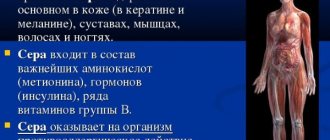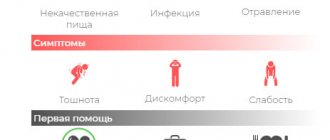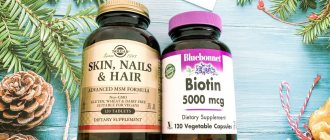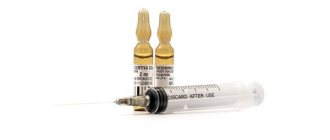- How do sorbents work?
- When are sorbents used?
- Who are sorbents contraindicated for?
- Sorbents for poisoning
- Sorbents for intestinal cleansing
- Sorbents for allergic reactions
- Sorbents for children
- Natural sorbents
- Sorbents: benefits and harms
Sorbents are substances that allow you to remove various toxins from the body. Sorbents can be of natural or synthetic origin.
Sorbents include enterosorbents - absorbing substances that act only in the gastrointestinal tract and bind toxins. They do not interact with gastric and other juices and leave the body naturally. This allows you to quickly and effectively rid the body of toxic (poisonous) substances.
Filtrum is a natural enterosorbent that binds and removes alcohol, allergens, pathogenic bacteria and bacterial toxins, medications, poisons, and heavy metal salts from the body.
How do sorbents work?
Enterosorbents have direct and indirect therapeutic effects.
These drugs:
- capture poisons and substances foreign to the body that come from the external environment;
- retain digestive products formed in the intestines on their surface;
- adsorb microbial cells and the toxins they release;
- bind gases formed during fermentation or putrefactive processes;
- cleanse digestive juices that are secreted into the intestinal lumen and contain many toxins;
- mechanically irritate sensitive areas of the intestinal wall and increase peristalsis;
- help restore the normal consistency of intestinal contents;
- lead to the transformation of highly toxic substances into compounds that are safe for the body.
This effect of sorbents is accompanied by the following therapeutic effects:
- weakening the severity of allergic reactions and poisonings;
- reducing the load on the liver – the main organ of detoxification;
- restoration of normal intestinal microflora;
- stimulation of restoration of damaged mucous membrane;
- elimination of bloating;
- improving blood supply to the intestines;
- normalization of water-salt metabolism.
Medications for withdrawal symptoms
This group is aimed primarily against hangover and withdrawal symptoms.
This includes:
- Vitamin complexes. Long-term consumption of alcohol-containing drinks destroys vitamins and accelerates their removal from the body. This creates a shortage of vital ingredients. Vitamin C improves immunity and tones the body, B vitamins accelerate blood flow and improve brain function, nicotine restores blood flow through the vessels, promotes detoxification, metabolism and liver function.
- Antihypoxants and metabolites - accelerate interstitial processes, saturate cells with oxygen, which leads to rapid oxidation of toxic substances. Often mildronate, fezam. Succinic and citric acids effectively fight hangovers. They activate tissue metabolism and the functions of organs and tissues, increase efficiency, mental ability, and reduce the toxic effects of alcohol molecules.
- Sedatives and sleeping pills. They allow you to improve the functioning of the nervous system and provide protection to its cells during withdrawal and recovery from it.
Combination medications have proven themselves to be effective:
- Cytoflavin – contains succinic acid, riboflavin (vitamin B2), nicotinamide (vit. PP), riboxin (metabolite). Cytoflavin enhances aerobic glycolysis and the synthesis of γ-aminobutyric acid in neurons, increases the resistance of glial and nerve cells to ischemia, accelerates blood flow and metabolic processes in the central nervous system. Its administration contributes to the regression of neurological symptoms, the elimination of disturbances of consciousness, and the return of cognitive functions of the brain.
- Reamberin – contains meglumine (N-methylglucamine), succinic acid, sodium, potassium, magnesium ions. Reamberin not only accelerates aerobic processes in cells, restoring their energy potential, but also has a moderate diuretic effect. It is administered intravenously (slowly!) at a rate of 6-10 ml/kg.
When are sorbents used?
First of all, sorbents are prescribed for food poisoning, drug poisoning, as well as when the human body is exposed to industrial poisons.
In addition, medications containing sorbents are used for:
- high acidity of gastric juice;
- flatulence;
- chronic renal failure;
- hepatitis, liver cirrhosis;
- allergic reactions;
- autoimmune diseases, incl. oncology.
Important! Sorbents must be taken separately from other medications, and the time difference between them must be at least two hours. If this rule is not followed, the therapeutic effect of taking sorbents will be sharply reduced and the absorption of medications taken simultaneously will be impaired.
Sorbents will also come in handy if you have abused alcohol. In case of alcohol poisoning, a large amount of alcohol breakdown products is present in the body, which is why the victim experiences unpleasant hangover symptoms. In such a situation, enterosorbents will help.
Sorbents are also effective for treating diseases caused by parasites, such as worms, lamblia or salmonella.
Finally, sorbents are used to enhance immunity.
Doctors advise conducting short courses of prevention using sorbents several times a year.
If you take sorbents as the main means of treatment, then you must simultaneously take probiotics and vitamin and mineral complexes. Your doctor will prescribe the exact course of treatment for you.
general information
In the process of life, various types of harmful compounds accumulate in our body, for example, toxins or waste products , which should be periodically gotten rid of in order to maintain good health and well-being. For these purposes, special adsorbents or absorbent preparations are used to cleanse the body, which are able to absorb toxic substances and safely remove them.
Such medicines will be indispensable for intestinal poisoning, as well as for alcohol or drug intoxication. They quickly neutralize harmful chemical compounds and alleviate the human condition.
Sorbents for poisoning
If you have suffered from poisoning, it is important to rid your body of toxic substances as soon as possible. This illness can affect anyone, so it is imperative to have sorbent preparations in your home medicine cabinet. When choosing a drug, pay attention to such characteristics of its action as:
- pronounced sorption (absorbing) ability.
- safety of use: sorbents should not enter the bloodstream and should be quickly eliminated from the body.
How to restore the nervous system after binge drinking
Since multi-day drinking sessions almost always bring the addict out of balance, making him aggressive and anxious, when withdrawing from binge drinking, medications are used that improve the functioning of the nervous system. Usually these are sedatives, which:
- normalize sleep;
- relieve overexcitation;
- relieve unreasonable anxiety;
- normalize blood pressure.
Medicines containing:
- Glycine. The product has neurotropic properties. Improves mental activity, relaxes. Positively affects the patient's intellectual abilities.
- Bromodihydrochlorophenylbenzodiazepine. This is an anxiolytic component. It is characterized by muscle relaxant, central, hypnotic and sedative effects.
- Diazepam. Anxiolytic and antiepileptic component. Reduces the likelihood of seizures, helps the patient cope with anxiety and fear. Perfectly relaxing.
If, during an examination of a person who is in a state of prolonged heavy drinking, a narcologist sees severe overexcitation and inappropriate actions, then he may decide to include tranquilizers and antipsychotics in the therapeutic program . The use of such drugs is allowed only under constant medical supervision , so the alcohol addict will have to go to a drug treatment hospital.
Sorbents for intestinal cleansing
Intestinal intoxication is manifested by such signs as bad breath, increased sweating, rash, white coating on the tongue, nausea, vomiting, bloating, flatulence.
Important! It is recommended to take sorbents an hour before meals or an hour after meals. The exception is situations when it is necessary to urgently remove toxins from the gastrointestinal tract. In this case, the sorbent should be taken 20 minutes before meals or immediately after you feel the symptoms of poisoning.
Medications to help prevent relapse after withdrawal from binge drinking
To minimize the likelihood of repeated drinking after binge treatment, narcologists sometimes use drugs that cause individual intolerance to alcohol-containing drinks. Such medications should never be combined with alcohol. They are administered upon completion of detoxification. The patient must be warned about this.
Compositions containing disulfiram have proven themselves to be excellent. When combined with ethanol, they provoke nausea, vomiting, increased blood pressure, severe weakness and other unpleasant symptoms. Knowing that the administered drug is incompatible with ethanol, the patient consciously restrains himself from participating in another drinking session.
Since all disulfiram-containing products exhibit a pronounced aversive effect, their use must be treated with maximum responsibility. They should never be secretly mixed into the patient’s food or drinks. They are also not prescribed to persons with a history of stroke, myocardial infarction, or those prone to hypertension.
For unadvanced alcoholism, doctors sometimes prescribe the medicine Proproten-100 . It belongs to the pharmacological category “Medicines for the correction of disorders in alcoholism, toxicity and drug addiction.” Contains antibodies to brain-specific protein S-100. The drug is available at the pharmacy without a prescription, but it is clear that you cannot use it without first obtaining medical advice.
Sorbents for allergic reactions
If an allergy is diagnosed, the doctor will recommend a diet that is right for you and involves gradually adding to the diet a product that causes an allergic reaction. If the body again rejects the allergen, the doctor reviews the diet.
If you have allergies, your doctor may prescribe a sorbent as a component of complex treatment, along with antihistamines. Severe allergic reactions are treated in a hospital, where the patient is prescribed antihistamines, anti-inflammatory drugs, and hormonal drugs.
Herbs and fees
It should be noted that there are a fairly large number of folk remedies that can be used for heavy drinking. Some of the herbal medicines in the form of special filter bags are sold in modern pharmacies. These include:
- Stopped. The composition includes a large number of herbs: tansy, centaury, thyme, wormwood and others. They can improve digestion, choleretic processes, psycho-emotional background, and also significantly reduce the craving for drinking alcohol.
- Aralia tincture. Helps restore adrenal function and strengthen the nervous system.
All of them are sold without a prescription.
Need some advice?
OR CALL A DOCTOR
CALL!
+7
Sorbents for children
Sorbents can also be used to cleanse a child’s body, but they can only be used by children as prescribed by a doctor.
Not all medications containing sorbents are suitable for children. One of the few universal remedies is the drug "Filtrum", which is approved for children under one year of age.
"Filtrum" is prescribed for poisoning and infectious diseases of the intestines, such as salmonellosis or dysentery. The tablets are crushed to powder before use. Babies under one year old should be given half a tablet per dose, children from 1 to 7 years old should be given one tablet per dose, and older children should be given 1-2 tablets per dose. The number of appointments per day is no more than four.
Sorbents are also used for allergic reactions in children, as they help rid the body of the effects of the allergen. In this case, the indications for use in children coincide with the indications for adults.
Important: before use, read the instructions or consult your doctor.
Content:
- Detox and overcoming withdrawal are the main tasks in the treatment of binge drinking 1.1. Anti-binge drugs with detoxification activity 1.2. Anti-binge medications that relieve withdrawal symptoms
- How to restore the nervous system after binge drinking
- Medications to help prevent relapse after withdrawal from binge drinking
By binge drinking, narcologists mean a condition when an alcohol addict drinks alcohol in large quantities for more than a day. Breaking out of binge drinking is a very responsible procedure. It is in no way connected with the use of cucumber and cabbage pickles, as many people think. Special medications must be used here to neutralize ethanol toxins and improve the functioning of internal organs.
The wisest thing to do to get out of binge drinking is to seek help from experienced narcologists. Doctors will draw up an individual rehabilitation plan that will minimize the damage to health. Self-medication for severe alcohol poisoning is dangerous.
Natural sorbents
Medicines contain sorbents of natural and synthetic origin. Natural sorbents can also be used in their natural form. Most often, sorbents of natural origin are found in plants. For example, pectins have a high absorption capacity, the fibers of which, when they enter the gastrointestinal tract, swell and release a gel-like substance. Pectins allow you to remove excess water, as well as heavy metals (mercury, lead and strontium), and bind excess cholesterol in the intestines, which helps fight atherosclerosis.
Pectins are found in seaweed, apples, citrus fruits, raspberries, and strawberries. They are also rich in cereals (buckwheat, oatmeal) and some vegetables, including beets, carrots and cabbage.
A number of other natural sorbents with pronounced medicinal properties are also known:
- Plant fiber - allowed for long-term use.
- Chitin - helps cleanse the body of cholesterol and fatty acids. This sorbent is often recommended for those who are on a diet, suffer from diabetes and atherosclerosis, as well as those who plan to take part in a lavish feast.
- Cellulose - helps reduce cholesterol and sugar levels, fight excess weight. Promotes the growth of beneficial microorganisms in the intestines and improves digestion. With prolonged use of Cellulose, addiction develops, so the dosage is gradually increased. Remember that cellulose and chitin can only be taken separately from each other.
Enterosgel
The drug is produced in the form of a paste (aqueous suspension) and gel. The organosilicon compound included in the drug has detoxifying and adsorbing properties.
Enterosgel
It effectively removes toxins of exogenous and endogenous origin from the body, as well as their breakdown products, suppresses allergens , binds heavy metal salts and fights alcohol intoxication .
Indications for use:
- diarrhea;
- dyspeptic intestinal disorders;
- intoxication;
- disturbance of intestinal microflora;
- liver and kidney failure;
- skin diseases;
- allergy;
- toxicosis;
- ulcer;
- oncology.
Absolute contraindications to taking the drug are:
- individual intolerance to the constituent components of the drug;
- lactation;
- age up to 1 year;
- poisoning with cyanides, alkalis, acids and some solvents ( methanol, ethylene glycol and others);
- intestinal obstruction and .
Among the most common side effects, the possibility of constipation in the first days of taking the drug is noted. It is worth noting that Enterosgel and licorice can effectively cleanse the body’s lymphatic system of accumulated harmful compounds and thus improve immunity . Licorice root promotes the release of waste and toxins , and polymethylsiloxane polyhydrate contained in the sorbent removes them from the body without harm to health.
White coal
An absorbent preparation based on microcrystalline cellulose and silicon dioxide , available in the form of tablets or powder for suspension. The main advantage of white coal is its high efficiency and sorption capacity.
Its daily dose is ten times lower than that of similar drugs. In addition, white coal does not cause constipation , and therefore quickly cleanses the body of harmful compounds.
Indications for use:
- food and alcohol poisoning ;
- intestinal infections;
- liver and kidney failure ;
- helminthiasis;
- dermatitis;
- allergy;
- dysbacteriosis;
- hepatitis A , B.
Contraindications:
- individual intolerance;
- erosion of mucous membranes;
- stomach ulcer;
- lactation;
- bleeding of the gastrointestinal tract;
- intestinal obstruction.
Phosphalugel
A drug based on aluminum phosphate , which has antacid, absorbent and enveloping properties. The active medicinal compound of Phosphalugel neutralizes hydrochloric acid and prevents hypersecretion of gastric juice. Protects the mucous membranes of the gastrointestinal tract and promotes their regeneration. Blocks the harmful effects of pathogenic microorganisms, normalizes intestinal function.
Indications for use:
- diarrhea;
- ulcer;
- gastritis;
- diaphragmatic hernia;
- gastroesophageal reflux;
- non-ulcerative dyspepsia ;
- intoxication.
Phosphalugel is contraindicated in case of individual intolerance to the drug, as well as in case of kidney dysfunction . It is extremely rare that the drug can cause constipation in elderly patients and bedridden patients. The sorbent reduces the effectiveness of some drugs, for example, tetracycline antibiotics , iron supplements or cardiac glycosides.
Smecta
The powder, which is a mixture of aluminum and magnesium of natural origin for the preparation of a water-based suspension, has adsorbent and antidiarrheal properties.
Smecta
Helps remove toxins from the body and suppresses flatulence . It is considered one of the safest and can be used in the treatment of infants.
Indications for use:
- diarrhea;
- dyspepsia;
- irritable bowel syndrome;
- intoxication;
- vomit.
Contraindications:
- intestinal obstruction;
- hypersensitivity to the main components of the drug;
- fructose intolerance;
- malabsorption syndrome;
- chronic constipation ;
- osmotic diarrhea.
Rare side effects may include constipation , increased flatulence or vomiting . You should take other medications 1.5-2 hours after using Smecta.
Cleansing the body with magnesium
Magnesium sulfate , popularly known as magnesia , is a powdered compound that has laxative properties and is used to cleanse the gastrointestinal tract. By increasing the volume of feces, intestinal motility improves and, along with its emptying, harmful salts of heavy metals, as well as other compounds, are removed from the body. This method will be most effective for chronic constipation , biliary dyskinesia and cholecystitis .
Contraindications:
- appendicitis;
- intestinal obstruction;
- hypersensitivity;
- renal failure;
- dehydration;
- diseases of the heart system;
- rectal bleeding.
magnesium- based drugs are used incorrectly or too frequently, side effects may occur such as:
- vomit;
- fast fatiguability;
- nausea;
- exacerbation of chronic gastrointestinal diseases;
- confusion;
- flatulence;
- arrhythmia;
- diarrhea;
- feeling of thirst;
- uterine atony;
- convulsions;
- asthenia;
- dyspnea;
- increased anxiety.
All these negative consequences occur because... Sorbent preparations do not work selectively and remove not only harmful, but also useful compounds. As a result, a person’s well-being may deteriorate due to a lack of important macro- and microelements in the body. Therefore, it is strictly forbidden to self-medicate and use sorbent substances without prior consultation with a specialist.
Sorbents: benefits and harms
It is important to remember that sorbents not only provide benefits, but can also have some negative effects. Along with toxins, they are able to remove beneficial substances from the body. True, in case of serious disorders of the body, such a side effect is much less important than the real benefits that sorbents bring.
To summarize, we can say that thanks to sorbents, we help our body more effectively get rid of accumulated toxins, allergens and other harmful substances.
Activated carbon
This absorbent can be considered the most universal medicine. Every person has it in their first aid kit, because... has a wide range of applications.
Activated carbon
In the process of obtaining this drug, natural carbon-containing raw materials (charcoal) are used.
It has pronounced enterosorbing, antidiarrheal, and detoxification properties.
Activated carbon absorbs well and removes from the gastrointestinal tract:
- poisons;
- barbiturates;
- glycosides;
- alkaloids;
- plant, animal and bacterial toxins;
- salts of heavy metals;
- drug breakdown products;
- gases;
- derivatives of hydrocyanic acid and phenol;
- sulfonamides.
Its microporous structure attracts negative ions of toxic compounds and holds them in the crystal lattice, thereby preventing them from entering the bloodstream.
The drug is effective for:
- intoxication (food, alcohol, etc.);
- increased flatulence ;
- bloating;
- dyspepsia (indigestion);
- diarrhea;
- atopic dermatitis or bronchial asthma of allergic origin;
- decreased secretion of hydrochloric acid, which is part of the gastric juice.
Activated carbon is also prescribed to eliminate the effects of rotting and fermentation processes in the intestines. This drug helps with liver cirrhosis , salmonellosis , chronic and viral hepatitis , kidney failure and dysentery . In addition, the absorbent is used in preparatory activities before conducting an ultrasound examination or x-ray of the gastrointestinal tract.
Contraindications:
- individual intolerance;
- exacerbation of duodenal or gastric ;
- tendency to constipation ;
- atony , obstruction or bleeding in the intestine;
- hemorrhoids;
- taking other types of sorbent compounds or antitoxic drugs.
Side effects:
- exhaustion of the body , because the drug removes not only toxic, but also beneficial compounds;
- dehydration , constipation , liver damage and worsening intoxication while taking the absorbent are possible, because it absorbs a large amount of liquid.
Preparations - analogues, which include activated carbon:
- Karbolen;
- Sorbex;
- Carbactin;
- Carbolong.







